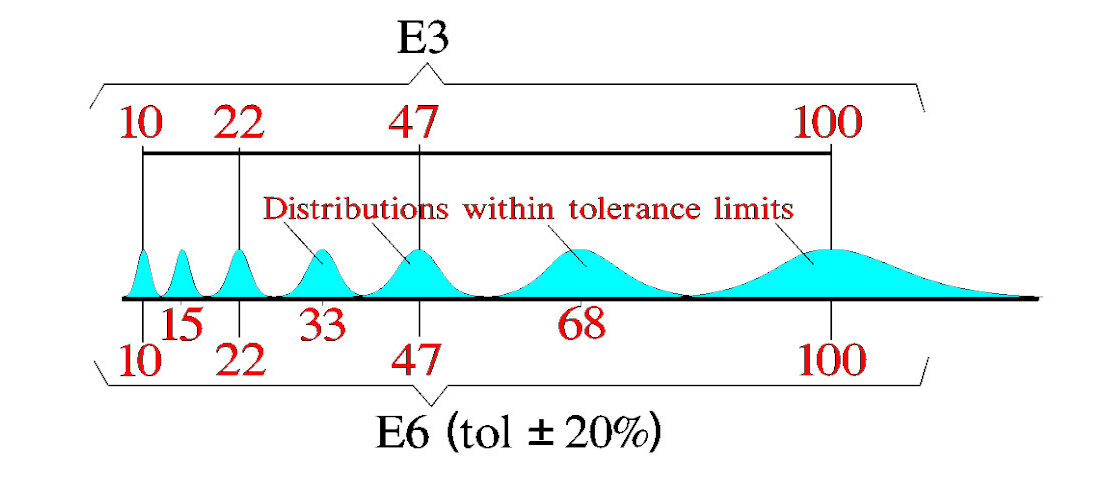
Standard values for capacitors and resistors
- Posted by doEEEt Media Group
- On August 9, 2020
- 0
Why 27pF and not 25pF? Why do I need to use a 47µF capacitor instead of a 50µF device? We explain why capacitors (as well as resistors and inductors) have funny values.
Just like most passive components, capacitors come in standard values. These values are based on a geometric series, commonly referred to as the E series. Although it is practically possible to produce a component of nearly any capacitance value, manufacturers use preferred values for ease of manufacturing passive components. Apart from defining values for passive components, this system, based on progressive ratios, specifies recommended tolerances. Standardisation of component values allows manufacturers of passive components such as capacitors, resistors, and inductors to manufacturer components with ease.
The preferred number series (E series)
The International Electrotechnical Commission (IEC) defined the preferred number series in 1952 with the aim of enabling manufacturers to produce passive components more easily. The E series defines capacitance and resistance values as well as tolerances for capacitors and resistors. These standard values are published in the IEC standards, IEC 60063:1963 and IEC 60063:2015. Whereas the IEC 60063 defines the preferred values and tolerances, the IEC 60062 defines marking codes for capacitors and resistors. The E series has been adopted by various international standard organizations including the Electrical Industries Association (EIA).
The sizes, colour codes, and values of passive components are based on international standards. There are many benefits of standardisation of component values. Since the preferred number series uses a logarithmic scale with spaces that are approximately equal, it limits the values of components that manufacturers are required to produce. Moreover, standardisation of component ensures compatibility of components. As such, engineers are not limited to components from a specific manufacturer. They can get compatible capacitors and resistors from any suitable manufacturer.
The E series defines preferred values for the capacitance of capacitors and resistance of resistors as well as recommended tolerances. This series is essential for the coding and marking of capacitors and resistors. On the other hand, the IEC 60062 standardises coding and marking for capacitors and resistors. The E series is derived from progressive ratios of nth root of 10, where n=2ix3 and i is a whole number (0-6). The value n specifies the number of elements in a decade. For instance, the E12 series has 12 elements per decade while the E48 series has 48 elements per decade.
The E24, E12, E6, and E3 series
The values of the E24 series are obtained by rounding the theoretical numbers of the geometric series (with n=24).It is important to note that some values of the E24 series deviate from the mathematical rule. The values of the E12 series are obtained by omitting every second term of the E24 series. Similarly, the values of the E6 series are obtained by omitting every second term of the E12 series. Lastly, the values of the E3 series are obtained by omitting every second term of the E6 series. Table 1 shows the values of the E24, E12, E6 and E3 series.
The E192, E96, and E48 series
The E192 series is obtained from the geometric series (with n=192). The theoretical values obtained from the series are rounded to three significant digits. The E96 series is obtained by omitting every second term of the E192 series. Similarly, the E48 series is obtained by omitting every second term of the E96 series. The full range of standard component values consists of decimal multiples and sub-multiples of E192, E96, and E48 values provided in Table 1.
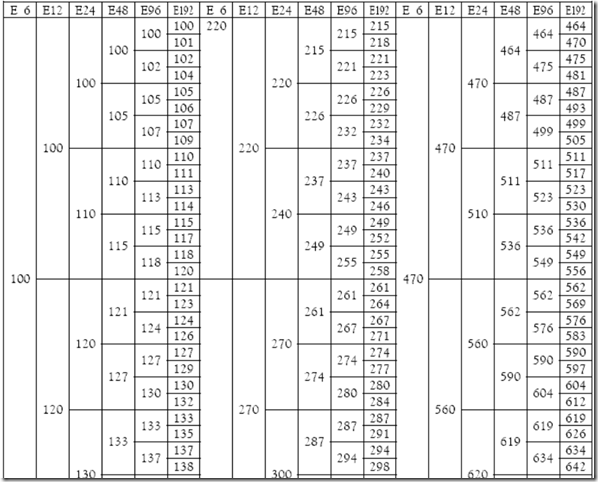
Table 1: E48, E96, and E192 series
ALTER TECHNOLOGY
Laboratory Services Brochure
ALTER laboratory services include parts procurement to equipment testing, including packaging design and assembly, screening, DPA, qualification, evaluation of counterfeits, and many more.
Tolerances for capacitor and resistor values
Unlike resistance, capacitor values are usually defined in two significant digits. It is, therefore, not common to apply the E48, E96, and E192 series and recommended tolerances. In most cases, capacitor manufacturers use tighter tolerances for these passive components. It is common for capacitor manufacturers to use a tolerance of ±1% with E24 values.
Resistors are produced in standard values to simplify manufacturing, purchasing, handling, and designing processes. The preferred number series produces a spacing that relates component values to their tolerances. For conventional resistors, the tolerances are ±20% (E6), ±10% (E12), ±5% (E24), ±2% (E48), and ±1% (E96). Some manufacturers produce resistors with more accurate tolerances at a higher cost. For resistors, the E96 and E192 series are less used. Table 3 below shows the number of values per decade and tolerances for the E3, E6, E12, E24, E48, E96, and E192 series.
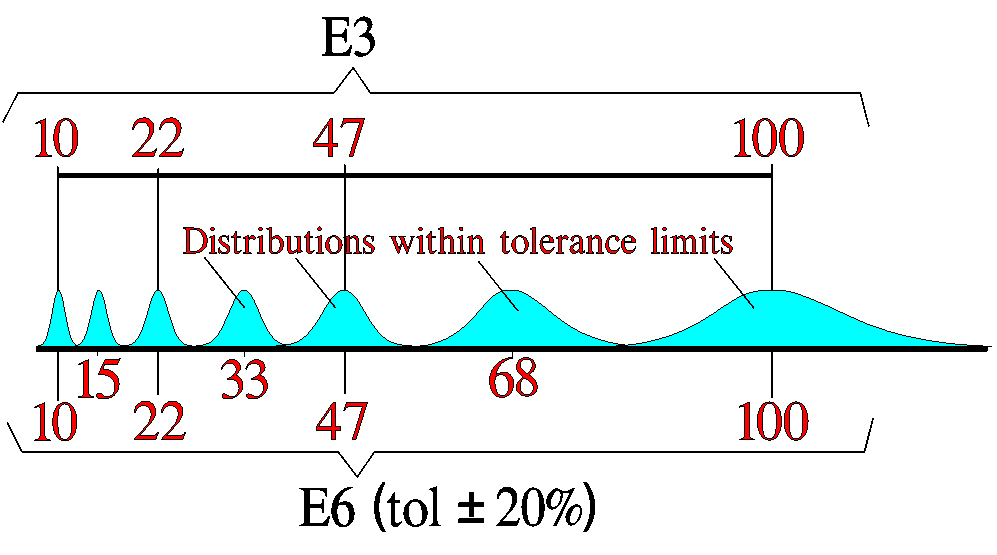
Table 2: E series and recommended tolerances
To obtain non-standard capacitance and resistance values, passive components are usually combined in series and/or in parallel. In most electronic systems, complex combinations of capacitors are used to meet the specific requirements of a circuit. For applications that require specific capacitance such as tuning, capacitors that allow manual or electrical adjustment of capacitance are used.
doEEEt provides you the most complete and updated information about Hi-Rel EEE parts
- Miniature RF Connectors for high-performance testing - April 24, 2025
- Space-Grade components available for immediate delivery - April 10, 2025
- Managing EEE components for LEO and lower cost space missions - December 17, 2024

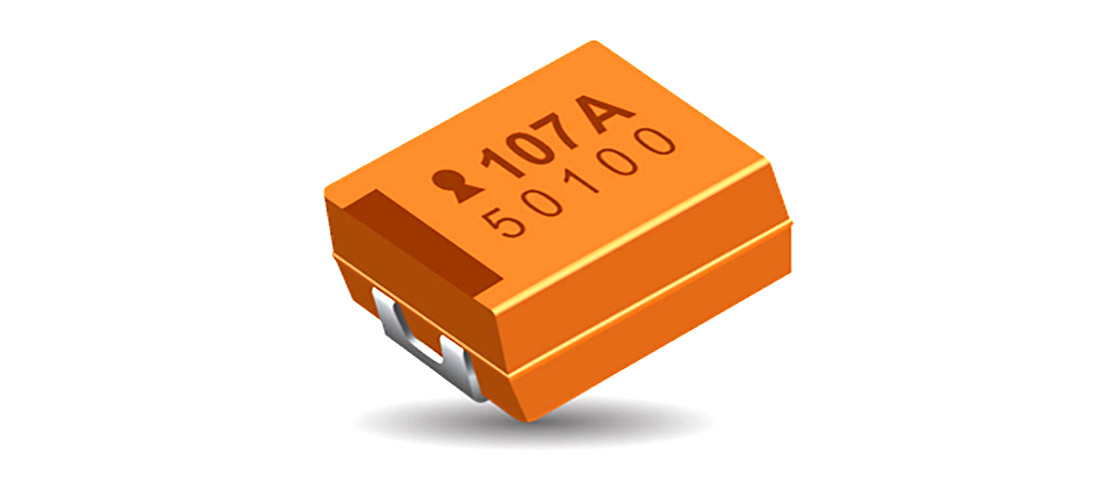
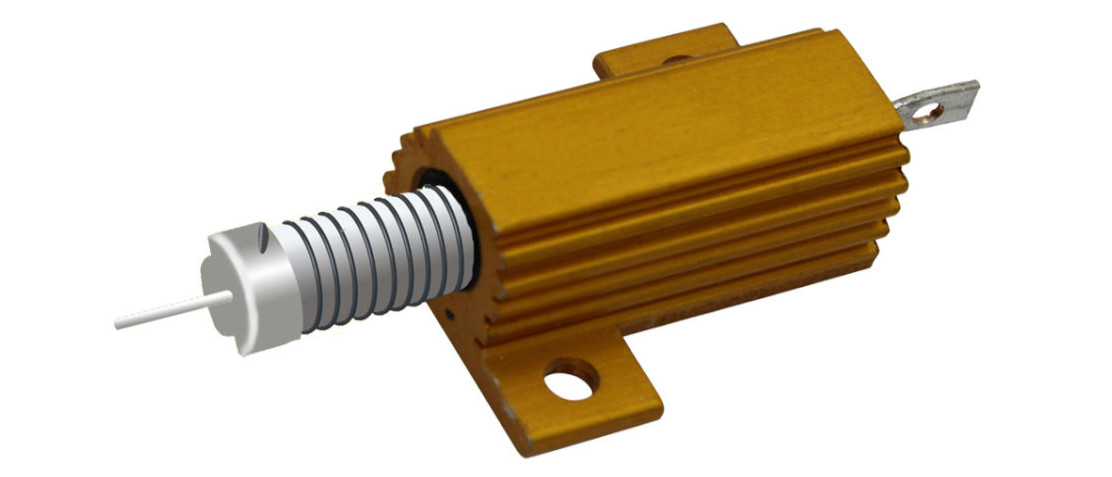
0 comments on Standard values for capacitors and resistors